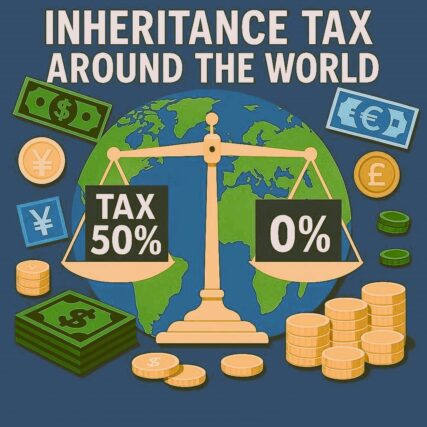「相続税って世界中どこの国にも共通してあるの?」
そんな疑問を持ったことはありませんか?
実は、世界の相続税制度は国によって大きく異なります。
相続税が、もともと無い国(中国、マレーシア、インド、UAE、モナコなど)の他、
相続税が、現在は廃止された国(香港、シンガポール、オーストラリアなど)があります。
相続税の課税が行われる国の中でも、課税方式は様々です。
課税対象となる遺産の下限(言い換えれば基礎控除をいくらに設定するか)と、税率の組み合わせが各国異なることが特徴的です。
例えば、イギリスの場合、現行税率は一律40%で基礎控除は£325,000(2025年の為替換算1£=200円として約6,500万円)です。
一方、一律税率ではなく、遺産額に応じて段階的に税率が上昇する累進課税の国としては、日本をはじめ、アメリカ、フランス、ドイツなどがあります。
日本の相続税は?
2025年現在、基礎控除は「3,000万円+600万円×法定相続人の数」です。
ところが、平成7年から平成27年までは基礎控除は比較的大きく「5,000万円+1,000万円×法定相続人の数」でした。基礎控除が減少したのは、バブル崩壊後に、資産再配分機能低下を回復させるための構造的な見直しの結果でした(相続税の改正に関する資料 : 財務省)。税率は10%~55%の累進課税となります。
例えば、法定相続人が、配偶者と子供2人であれば、法定相続人3名となり、基礎控除は4,800万円となります。この基礎控除を超える財産があれば、相続税の申告納税義務者に該当する可能性がある、ということになります。
アメリカの相続税は?
連邦税と州税がありますが、日本の国税にあたる連邦税の基礎控除額は、2025年現在$13.99million(2025年の為替換算1$=147円として約20億超)です。
そして、基礎控除額はトランプ減税(TCJA)の効果もあり年々上昇していました(Estate tax | Internal Revenue Service)。税率は18%~40%の累進課税となります。
基礎控除が20億となれば、まず日本との比較では次元が異なりますね。それだけ国内の富裕層に対する政策がダイナミックだと感じます。しかし、この減税政策は、2018年から2025年12月末までの時限立法だったのです。2026年1月以降に、TCJA発効前の水準に基礎控除が約半減する可能性があるのか、それとも政策延長となるのか、と注目されていました。
結局、2025年7月4日独立記念日に「One Big Beautiful Bill Act(OBBBA)」が成立し、2026年以降の基礎控除額は$15millionに上昇し、恒久化されることとなりました。2027年以降はインフレ調整も付加される見込みです。
このように、課税対象・基礎控除額・税率の設計が国によって大きく異なり、文化や政策の違いが反映されています。
今回は、主として基礎控除の変遷と、規模の違いが分かりやすい日米の制度の概略でした。
INHERITANCE TAX AROUND THE WORLD
“Is inheritance tax common worldwide?”
In fact, inheritance tax systems vary significantly from country to country.
Some countries have no inheritance tax at all, such as China, Malaysia, India, the UAE, and Monaco.
Others have abolished inheritance tax, including Hong Kong, Singapore, and Australia.
Among countries that do levy inheritance tax, the taxation methods vary widely.
Each country has its own combination of minimum taxable estate threshold (in other words, the level of basic exemption) and tax rate structure, which is a distinctive feature of their systems.
For example, in the United Kingdom, the current inheritance tax rate is a flat 40%, with a basic exemption of £325,000 (approximately ¥65 million, based on the 2025 exchange rate of £1 = ¥200).
On the other hand, countries that apply progressive taxation, where the tax rate increases according to the value of the estate, include Japan, the United States, France, and Germany.
Japan’s Inheritance Tax System
As of 2025, Japan’s basic exemption is calculated as:
¥30 million + ¥6 million × number of statutory heirs
From 1995 to 2015, however, the exemption was more generous:
¥50 million + ¥10 million × number of statutory heirs
This reduction was part of a structural reform aimed at restoring the asset redistribution function after the collapse of Japan’s economic bubble (Source: Ministry of Finance相続税の改正に関する資料 : 財務省).
The tax rate is progressive, ranging from 10% to 55%.
For example, if the statutory heirs include a spouse and two children (three heirs in total), the exemption would be ¥48 million.
If the estate exceeds this amount, the heirs may be subject to inheritance tax filing and payment obligations.
The U.S. Federal Estate Tax
In the U.S., both federal and state-level estate taxes exist.
The federal exemption—comparable to Japan’s national tax—is $13.99 million in 2025 (approximately ¥2 billion, assuming an exchange rate of $1 = ¥147).
This exemption amount has increased annually thanks to the Tax Cuts and Jobs Act (TCJA), often referred to as the Trump tax cuts (Source: IRS – Estate tax | Internal Revenue Service).
The federal estate tax rate ranges from 18% to 40%, also progressive.
With an exemption of ¥2 billion, the scale is clearly on a different level compared to Japan.
It reflects a more dynamic policy approach toward domestic wealth.
However, this tax relief was enacted as a temporary measure from 2018 to the end of 2025.
There was considerable attention on what would happen after January 2026—whether the exemption would revert to pre-TCJA levels (effectively halving), or whether the policy would be extended. Ultimately, on July 4, 2025—Independence Day—the “One Big Beautiful Bill Act (OBBBA)” was passed, permanently raising the exemption to $15 million per individual starting in 2026. Beginning in 2027, the exemption will also be adjusted for inflation.
Global Diversity in Inheritance Tax Design
As this example shows, taxable scope, exemption thresholds, and rate structures differ widely across countries, reflecting unique cultural and policy priorities.
This article focused on the evolution of exemption amounts and the scale differences between Japan and the United States.


